By Donna Furey | LB Indy
The Sawdust Festival of the ’60s was rustic, funky and electric.
The crowds, the music and lights, and the characters in peasant dresses, long hair, and boots; combined, they overwhelmed visitors’ senses. Towering booths, pungent odors and the art itself made the Sawdust Festival “a happening.”
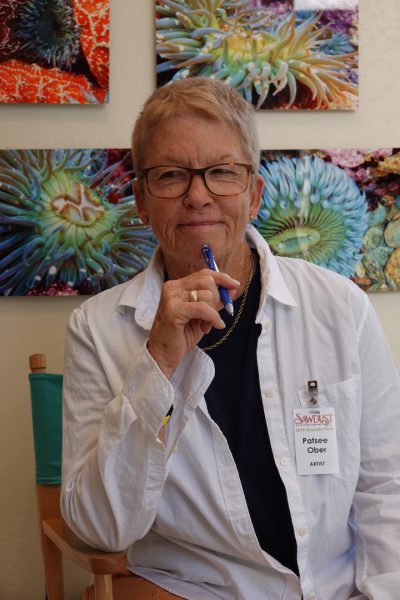
It was a “hippie village,” said Patsee Ober, who has been attending since the ’70s and is still a fan of the festival, but now also an exhibitor and board member.
“We’re not what we were in the ’60s,” she noted, and neither is the festival.
Although still funky, it has evolved over the years.
“Some of the magic of the ’60s has worn off,” admitted silversmith David Nelson, a 50-year exhibitor, who also remains a staunch supporter of the festival.
Nelson, 66, is part of a group of volunteers who spent countless hours designing two new booths for this year’s festival which do not contain any art.
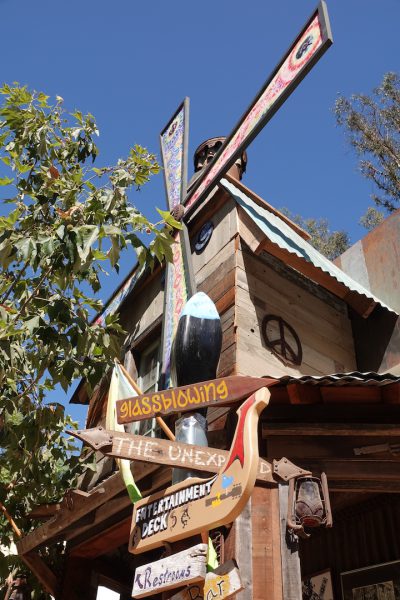
The new booths are tributes to the funky roots of the festival and they provide a perfect Instagram-ready backdrop.
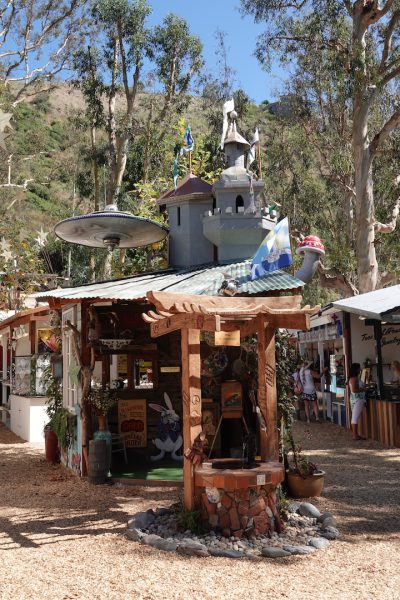
One features a windmill, blades painted in psychedelic colors, reminiscent of a booth made in 1970 by Phil Mueller for the welder and painter Tracey Moscaritolo. The other is topped by a flying saucer, an ode to the 1973 spaceship booth built from chicken wire and spray-on foam — a departure from the traditionally rustic, wood booths. In addition, it sports a castle turret, which pays homage to the 1970s booth of “Dragon Tales” creator and exhibitor Ron Rodecker.
In front of the two tribute booths sits a wishing well with a sign christening it “the unstoppable well of creativity.”
Torn down every January and rebuilt in May, the booths remain a central component of what loyal festival-goers look forward to seeing each year. To promote quirkiness, there is generally just one right angle in each structure, “there used to be none,” said Olivia Batchelder, a painter and 31-year exhibitor.
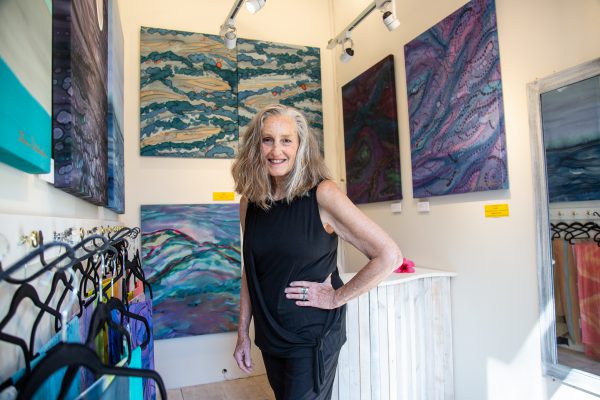
The walls of Batchelder’s booth are covered with large paintings made using liquid dyes and watercolor techniques and brushes.
“I like to work on silk canvas because of the natural luminosity of this material. It seems to refract light from within, giving a very serene quality,” the artist, 73, said.
Texturing materials such as alcohol and salts enhance the finished product. She began making hand-painted silk scarves and dresses, but, like the festival itself, her work has evolved. All of her paintings are influenced by nature. On the back wall of her booth hangs a diptych titled “Mojave Jiggle,” inspired by the July 4 earthquakes near Ridgecrest and depicting the colors of the desert.
In the early ’70s, Batchelder was living in New York when her roommate received a renewal notice for a Laguna Beach post office box, which she immediately tore up. Missing California, Batchelder taped the notice back together, substituted her own name, and mailed it with the $8.50 fee. A month later, she was back in California and by 1975 she had graduated from University of California, Irvine, with a bachelor’s degree in studio art.
The first official Sawdust Festival sign was erected in 1968 in the three-acre eucalyptus grove, the site of today’s festival at 935 Laguna Canyon Rd. When the art show began in 1965 it was held in a vacant lot near the Laguna Beach Public Library; it was called the “Rejects Festival” as some participants had been juried out of the Festival of Art. The following year it was held in another vacant lot on Coast Highway where sawdust was used to mitigate the dust. Journalists dubbed it the “the sawdust festival.”
Initially entrance to the Festival was free, but in order to purchase the eucalyptus grove land, the board voted in 1972 to charge an admission fee.
The artists incorporated as the Laguna Artists and Gallery Owners Association in 1967, and in 1970 the articles of incorporation were amended making the Association a nonprofit entity. Five years later the name was changed officially to Sawdust Festival Corporation.
With limited funds and no small amount of squabbling, the Sawdust artists established by-laws and show rules and had built the present façade by the end of the ’80s. Batchelder had become a member of the Laguna Beach Craft Guild and was selling hand-painted silk scarfs at the Cliffs at Laguna Village on weekends. In 1988, she came to the Sawdust Festival. The end of her first season marked a turning point in her career; she invested in a professional steamer, a tool that sets the color in the silk and tossed her garage sale pressure cooker previously used for that purpose.
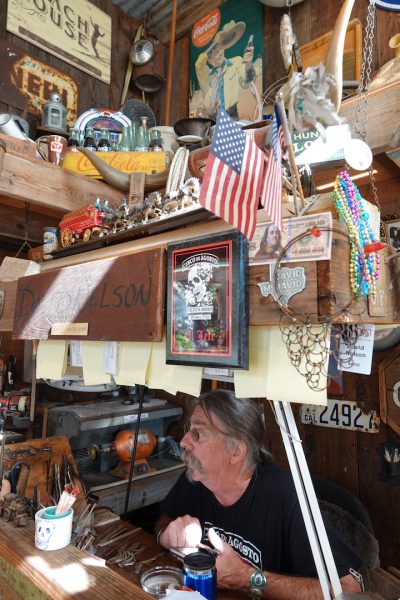
Nelson shows up to his booth every day of the festival and gets to work on his many custom orders from repeat clients and new customers. Artists are encouraged to demonstrate their process. All Sawdust artists must live in Laguna Beach and sell only work they create. While he laments the fact that fewer artists can afford to live in Laguna these days, he has a great deal of pride in all the roles he’s played in his years at the festival. He chaired the grievance committee for eight years, helped found the benevolent fund, has taught classes and helped start the Winter Fantasy to name a few of his contributions. He also takes pride in the memorial to the 118 artists and staff who have now passed, but are remembered with a plaque and a sculpture made by the glassblowers and dedicated in 2012. The plaque honors their contributions to the show and pays tribute to their “legacy of hard work, creative genius and friendship.”
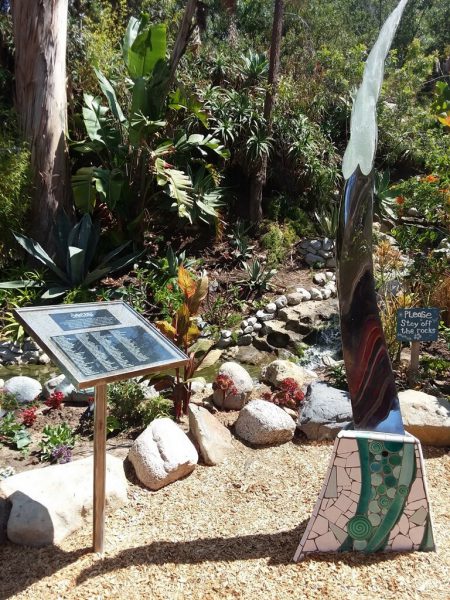
Ober, an underwater photographer, is enthusiastic about retaining the flavor of the festival while bringing it to the next level. She applauds the vision of ceramicist and board president Monica Prado and is excited about the new marketing and public relations firm recently hired.
“We’re improving transparency and simplifying the by- laws,” she said of the board, which has four new members.
Prado is in her first year as president and previously served as secretary. For next summer she’s inviting the artists to “dream big” using a technique called “vision casting” and will hold a roundtable meeting to discuss new ideas for the festival.
What hasn’t changed is the Sawdust’s commitment to promoting art created by local Laguna Beach artists and the commitment by artists to retaining its funky, if a more mellow vibe. As a non-juried show, the festival plays a vital role in supporting the careers of many local artists.
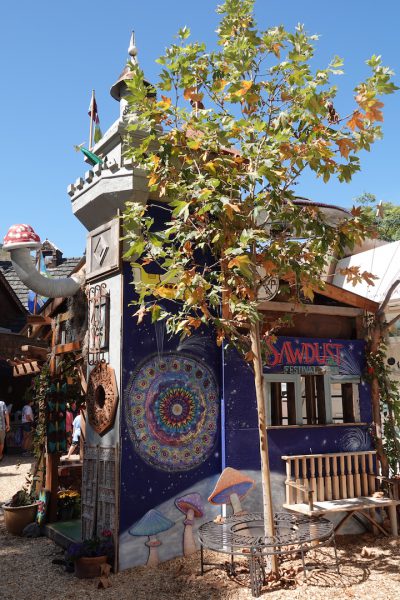
“This show is a gift to the artists,” Nelson said, adding that the $1,250 entrance fee is modest compared to what it would cost the artists to exhibit at out of town shows considering their fees and the cost of lodgings. As a nonprofit organization, the Sawdust offers classes, workshops and artist demonstrations to fulfill its mission of educating the public. Scholarships are also awarded to high school art students.
The Sawdust Festival runs through Sept. 1. Tickets are $4 – $9 and are available online at sawdustfestival.org or at the box office. Locals with ID are admitted for free on Thursdays after 5 p.m. Check the website for free admission days to residents of neighboring cities and counties.




